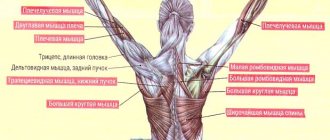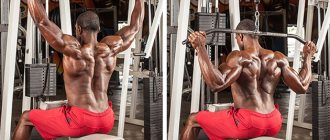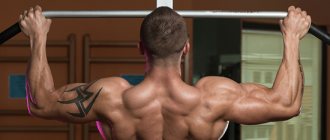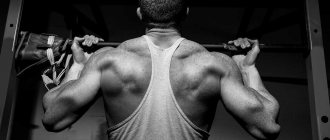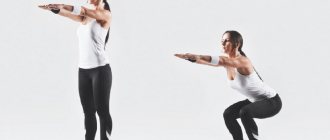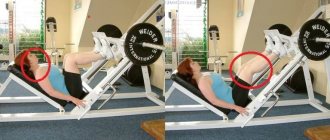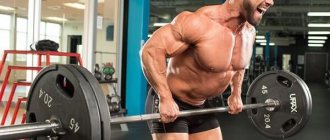Working muscles
Thanks to this exercise, a large number of muscles of the back, arms and chest are involved.
Basic
Mainly involved:
- teres major muscles;
- lats;
- biceps;
- brachial muscle.
Additional
When performing various types of deadlifts, additional muscles work:
- trapezoidal;
- diamond-shaped;
- pectoralis major;
- small pectoralis.
A person has more than 400 muscles. Each performs strictly its own specific function.
Basic mistakes
When performing this exercise, many novice athletes make very serious mistakes, which significantly reduce its effectiveness and inhibit the development of the back muscles:
- Lifting the buttocks off the surface of the bench. This changes the position of the body, which in turn can negatively affect technique.
- Rounding the back. Due to this error, not only the execution technique, but also the health of the athlete may suffer, since his spine will be in an unnatural position.
- Engaging the biceps. When performing traction movements on a block simulator, you should exclude third-party muscle groups from the work as much as possible. Very often, beginners pull the handle with emphasis on their arms, thus putting a lot of stress on the biceps. To prevent this from happening, it is necessary to perform the movement as we wrote in the instructions above.
- Incorrect weight. If an athlete takes a weight with which it is difficult for him to perform lat pulldowns with a narrow parallel grip, then, firstly, his execution technique will be greatly affected, and secondly, this can lead to serious injuries to the shoulder or elbow joint.
- Lowering the handle to the stomach. With this technique, the target muscles that this exercise is aimed at working out are switched off.
- Lean forward. In this position of the body you will not achieve the desired results. In addition, overloading your back can easily cause injury.

Exercise options and technique
This exercise can be performed in several ways.
Straight-grip chest row
When performing lat pulldowns to the chest, you need to take the handle of the machine with the widest possible grip, much wider than your shoulders. Then you need to sit tightly on the bench and press your hips with the upper bolster. Having assumed the starting position, you can begin the deadlift by jerking the handle towards you. Next, it should be pulled up to the upper chest. Not the entire movement should be performed as a jerk, but only the first part.
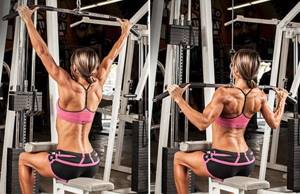
In the rest of the exercise, you need to tighten the handle by straining your back muscles. At the end of the exercise, it is advisable to bring your shoulder blades together and hold it for a couple of seconds, while straining your back. The handle of the exercise machine must not be lowered sharply to return to the starting position. It is necessary to smoothly, straining your back, return the handle back.
For information on the technique of performing lat pulldowns to the chest, watch this video:
In this design, the middle of the back works. Some athletes perform this exercise while leaning back. Thanks to this, the latissimus dorsi muscles work. But if the goal of the workout is a pumped-up back, then the body should be kept perpendicular to the bench.
You cannot pull the handle using your body weight and return it back with muscle force. This can cause ligament damage.
Close-grip chest row
This exercise is similar to the previous one. But, when performing such a pull-down of the upper block to the chest, the handle of the machine must be taken with a reverse grip. In this case, the palms should be turned towards you and close to each other. When performing this exercise, the load is placed on the latissimus dorsi muscles.
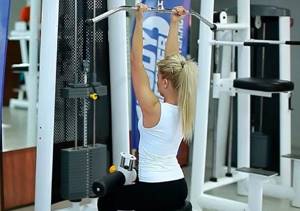
Description of the exercise
This exercise stretches the lats very well and works them well. At the bottom point, bend, meeting the handle with your chest, at the top point, lean forward a little. This will enhance the effect of this exercise.
Main features
1. This type of traction, firstly, is quite comfortable, and can be done by people with any degree of mobility in the joints. And secondly, it works better on the central part of the back. Including not only the latissimus muscles, but also the teres and infraspinatus muscles.
2. At the lowest point, you need to arch your back, squeeze your shoulder blades together and push your chest up. As if I meet the handle with my chest. And at the top point, it is advisable to move the body forward in order to better stretch the muscles.
3. If you don't know how to do pull-ups, this exercise will help you learn faster. Because it imitates pull-ups. The weight should be such that you can do at least 8 repetitions.
4. Alternatively, you can do rows with a wide parallel grip. For this you need a special pen. With this option, the load will be distributed more on the outer bundles of the latissimus muscles.
5. Try not to spread your elbows to the sides, but press them closer to your body. This will increase the efficiency of the exercise.
How to replace the exercise
If you can’t go to the gym, but want to use your back like when doing lat pulldowns, then you need to know what you can do to replace the exercise.
Alternative exercises for the same muscle groups
An alternative to the exercise is the pull-up bar. The same muscle groups are involved.
How to replace the draft of the upper block of the house
The question often arises: what can replace the draft of the upper block of the house? If you have a crossbar, then there is no problem. If it is missing, then you can come up with something else. For example, you can replace it with bent-over barbell rows. The back muscles are engaged from a different angle, but this does not matter - the main thing is that they work well. If you decide to perform the exercise with dumbbells, the grip can be straight (as with a barbell) or neutral (dumbbells parallel to the body).
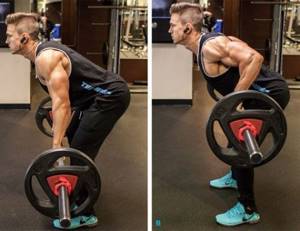
The second exercise to replace is the barbell pullover. It is performed while lying on a bench, with your arms and the barbell held behind your head so that the bar of the barbell is far from your forehead. This angle should be maintained throughout the entire movement. You need to work the barbell until your back feels a good stretch.
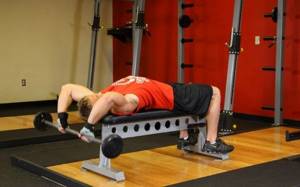
The pull-down of the upper block to the chest in a sitting position differs from pull-ups in that all attention can be paid to working the back. You can also change the weight, which is good for beginners. And remember - you can work out your back efficiently only if you follow the correct technique.
Wide grip lat row
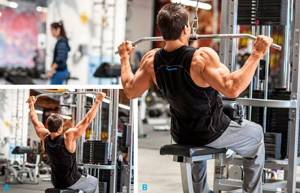
The lat pulldown with a wide straight grip (on the chest) is the most common option in fitness. The movement is suitable for those who cannot pull their heads, pull themselves up, or perform other movements. This exercise allows you to pump up the latissimus muscles, even if people have problems with strength and shoulder flexibility.
By training in a simulator, you can build up the “width of your back,” as athletes say. This movement allows you to press your shoulder blades towards your back and correct your posture. The exercise will help prepare the body for strength work - deadlifts and pull-ups.
Correct technique
- You need to choose the width of your grip so that your hands are slightly wider than your shoulders, but your shoulders can drop down and your shoulder blades can “pull” towards your spine;
- The grip is performed closed, standing facing the machine;
- Then the upper back bends slightly, the shoulders are removed from the ears, the shoulder blades are pulled towards the spine;
- The athlete sits on the machine bench, the body leans back a little, the chest rises up;
- The shoulders need to be turned back a little;
- The shoulder blades are pulled towards the spine;
- The lats gather, tighten towards the spine;
- Then the handle of the simulator is brought to the top of the chest;
- Peak muscle contraction is performed;
- The reverse movement consists of lowering the handle back
The movement is performed smoothly, without any pushing or jerking. It is important not to pull your biceps, not to throw your shoulders towards your ears, and not to yank the handle too hard. It is important to move the handle smoothly and not make the extension of your arms too large. Athletes think that the wider the grip, the better the back work, but this is not true. The grip should be chosen to be comfortable, so that it does not interfere with the work of the muscles.
Back workout. Upper block pull.
Common mistakes
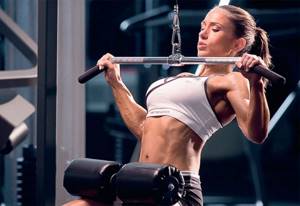
- The most common mistake is the biceps pull. The first thing a person does is bend his elbows, and by contracting his biceps, he pulls the handle toward his chest. This is not correct, and takes the strain off the back;
- You should not pull due to inertia, tilting the body back, and pulling the handle to the top of the back with a jerk;
- Pull to the middle of the abdomen without arching the back or tilting the body. This only allows you to pump up your biceps and “hammer” your trapezius, so you shouldn’t do that;
- It is better to avoid the option when the weight is too heavy and the person is literally “thrown” up;
- Throwing your elbows back allows you to develop exclusively the posterior deltoid muscle, but not the latissimus or rhomboid muscles;
- “Humping”, that is, rounding the back in the thoracic region, can lead to injury in the shoulder joint and remove the load from the target muscles
It is important to understand that this version of the exercise is for the upper bundles of the latissimus muscles. If the lower ones are not loaded, nothing bad happens. Is it possible to pull the block by the head? Modern fitness trainers rarely give their clients this exercise. Meanwhile, in bodybuilding and powerlifting it is used quite often. A condition for using this movement safely is good mobility of the shoulder joint. Pulls for the head are performed with significantly less weight than for the chest. It more specifically works the rhomboid muscles and helps retract the shoulder blades and stabilize the back in all strength exercises.
It's a lat pulldown, baby!
You are in the section:
Sports and beauty > Exercises for training > Pulldowns: technique and main mistakes
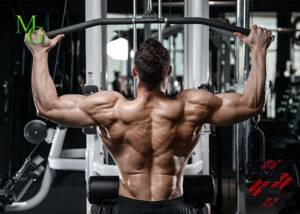
Good day to all! Today we will look at the exercise of pulling the upper block to the chest , analyze the execution technique and focus on the main mistakes .
The vertical chest row is a basic exercise and is great for both professional athletes and beginners. This simulator, with the correct technique, helps to work out the back muscles more safely, without overloading the spine and joints.
Of course, pull-ups are considered an ideal analogous exercise, but not everyone can boast of the ability to perform it in the required number of times with the correct technique. And the lat pull-down is considered an exercise to prepare for pull-ups.
The main types of pull-downs of the upper block to the chest
The exercise is aimed at working the latissimus dorsi muscle, but depending on the type of grip, the emphasis can be on the width of the latissimus dorsi and its lower part, as well as on the volume in general. Let's look at these options.
Wide grip lat pulldown to chest

This option is the most common among athletes and is responsible for the “wings,” that is, for the width of the latissimus muscles. But, despite the name, there is no need to perform the exercise with the widest possible grip, as the range of motion is reduced, which can negatively affect the result. Choose a comfortable grip that allows you to feel the work of your back muscles as much as possible.
Technique for performing lat pull-downs to the chest with a wide grip
Adjust the height of the bench so that your thighs are parallel to the floor, while your feet are firmly planted on the floor, and the bolsters are firmly secured to your thighs. Grasp the handle of the block using a comfortable grip. Experiment, start gripping slightly wider than the shoulders, the main thing is that the shoulders can go down and the shoulder blades come down to the spine.
Sit on the machine bench, fixing your hips, your back should be straight with a slight arch in the lower back, and lean your body back a little. This is the starting position.
As you exhale, focusing on the latissimus dorsi muscles, begin to squeeze your shoulder blades together, and at the same time bringing the latissimus muscles toward your spine, lower the handle to the top of your chest. As you inhale, smoothly return to the starting position, not fully straightening your arms so as not to remove the load from the target muscles, but at the same time stretching the target muscles.
Nuances and main mistakes:
- To ensure that most of the load falls on the back muscles, hold the handle of the block with an open grip;
- Lower the handle of the block exactly to the top of your chest, there is no need to lower it somewhere lower, thereby engaging not the target muscles, but your arms;
- To maximally load the latissimus dorsi muscles while pulling a block, perform a countermovement of the chest towards the handle of the block;
- Make sure that your elbows go down during the pull, that is, your forearms are like a continuation of the cable of your simulator;
- The movement of the handle must be strictly vertical.
Video: Technique for pulling the upper block to the chest
Row of the upper block to the chest with a reverse grip
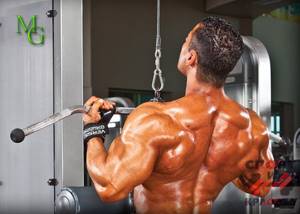
This exercise is aimed at pumping the lower part of the latissimus dorsi muscles, although if the technique is incorrect, the exercise turns into pumping the biceps of the arms. And this is extremely wrong, because there are separate exercises for the arms, so familiarize yourself with the technique in order to maximally involve the back muscles in the work.
Technique for performing lat pulldowns to the chest with a reverse grip
As in the previous exercise, set the bench to the desired height by correctly adjusting the clamping rollers. Take the handle of the block shoulder-width apart with a reverse grip and sit on the machine bench, fixing your hips under the special rollers. Keep your back straight with a slight arch in the lower back, arms extended upward. This is the starting position.
As you exhale, concentrating on the work of the latissimus dorsi muscles, pull the handle of the block to the top of the pectoral muscles, bringing the shoulder blades together as much as possible at the lowest point. As you inhale, return to the starting position.
Nuances and main mistakes:
- To avoid removing the load from the target muscles, do not fully straighten your arms at the top point;
- Make sure that the handle, or rather the cable with the handle, moves strictly vertically, only in this case you will use your back muscles as much as possible;
- Make sure that your back remains straight throughout the exercise; there is no need to round it.
Video: Technique for pulling the upper block to the chest with a reverse grip
Parallel grip lat pulldown to chest
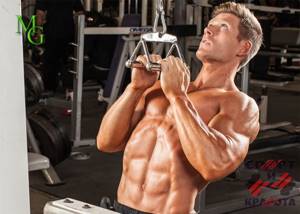
This option perfectly pumps up the latissimus muscles, rhomboids, teres major and trapezius muscles. The advantage of this exercise is the maximum range of motion.
The main emphasis is on the broadest muscles of the chest, but when the body is tilted back, the load will shift to the round muscles of the back.
Technique for performing lat pulldowns to the chest with a parallel grip
Usually this exercise is performed with a narrow grip with a special handle. Set the required weight, grab the handle with both hands with a parallel grip and sit on the bench, fix your hips under the special bolsters. The arms are straightened, the back is straight with a slight arch in the lower back, slightly tilted back. This is the starting position.
As you exhale, concentrating on the work of your back muscles, starting the movement by bringing your shoulder blades together, pull the handle to your chest, while exhaling, smoothly and under control, straightening your arms and stretching the target muscles, return to the starting position.
Nuances and main mistakes:
- Don’t forget that the main task is to fully load the back muscles, not the arms, so try to work exclusively with the target muscles;
- Do not throw the weight, all movements are conscious and controlled, otherwise there is a risk of spraining ligaments and joints. For the same reason, you should not fully straighten your arms at the top point.
Video: Pulling the upper block to the chest with a narrow parallel grip
Recommendations
- Do not proceed with the exercise without first warming up;
- If you are a beginner, develop the neuromuscular connection, that is, the Brain-Muscle connection, only in this case it will be easier to master the correct technique and see a positive result;
- Try to work specifically with the back muscles, otherwise the biceps will take the lion's share of the load;
- Do not chase weights, it is better to perform the exercise with the correct technique, and increase the weight as your muscles and ligaments strengthen. If you work with jerks, then reduce the weight so as not to spoil the technique;
- Perform this exercise in 3–4 sets of 10–12 repetitions.
Safety
The lat pulldown with a parallel grip is one of the simpler types of deadlifts. However, this does not mean that the exercise becomes so simple that the risk of injury is reduced to zero. This is not entirely true.
Most often, injury can occur if the shoulder joints relax too much while lifting up . At this point, the joint can easily become dislodged as the weight pulls it strongly upward. To prevent this from happening, the movement must be performed using muscle strength.
Deadlifts can stretch the spine . To further protect it, you should tense your abdominal and lower back muscles as much as possible. This is the only way the spine will maintain its natural deflection. If the athlete relaxes too much, he may suffer from vertebral misalignment.
Recommendations
You have already understood the technique and features of the exercise, now we would like to give you some useful recommendations that will help you make the parallel grip pull-down a safer and more effective exercise:
- Warm up before every workout. This applies not only to back training, but to all training in general. Many beginners do not pay enough attention to warming up, considering it simply unnecessary. Indeed, at first, when you work mainly with light weights, there may not be much need for a warm-up. But after some time, when the weights of the projectiles become heavier and heavier, the likelihood of injury will increase significantly. By warming up, a person prepares his muscles and joints for subsequent loads, which significantly reduces the risk of injury from exercise.
- Do the exercise technically. As we mentioned earlier, incorrect technique is one of the reasons for lack of results. Before adding an exercise to your program, make sure that you perform it efficiently and technically. If possible, ask a coach (or a more experienced athlete) to monitor your technique.
- Don't exercise too often. By working your back or any other muscle group several times a week, you will not only not speed up the growth of muscle mass, but, on the contrary, will slow it down significantly. Remember that muscles do not grow during training, but during rest!

We can put an end to this. We hope that this article was interesting to you and you gained a lot of new useful knowledge. We wish you success in your training!
